New Golf is the Answer; Which One is the Question
By John Gilbert
A car-buyer who strolls into a Volkswagen dealership to check on the 2015 Golf compact hatchbacks can be excused for feeling curious, impressed, confused, and overwhelmed — all in the space of several minutes. It’s like attending a dinner party, noting that available entrees includes your favorites, such as steak, pork chops, lamb chops, halibut, walleye, and salmon– and then you realize you have to select only one.
At the VW dealership, examining the Golfs used to be pretty easy. If you were seeking basic transportation you’d pick the base car with that pretty dull but smooth 5-cylinder engine. If you wanted the hot one, you’d pick the GTI with jacked up power, suspension and trim. And if you wanted the ultra-high-mileage version, you chose the TDI turbo-diesel and set off to pursue 50 miles per gallon. For the 2015 model, all versions of the Golf are improved, and with an electric version, a wagon, and a higher high-performance model, the decisions get more confusing but also more rewarding.
First glance may not betray any major change. The car looks pretty much the same, although a discerning eye can detect some rounding off of the squarer corners to streamline the aerodynamics of the boxy vehicle. You can’t tell that it’s mounted on VW’s new MQB platform, which will underpin all VW sedan models and a few Audis as well, and sits an inch lower, 2 inches longer and a bit wider than the 2014 Golf. Or that the new car is built of 80-percent high-grade steel, making it lighter and with an obvious improvement in torsional rigidity.
That squarish 4-door shape houses 52.7 cubic feet of interior room, an increase over the 2014 model, and more than many midsize cars. Inside, the appearance is mostly black in, with a little satin-finish trim here and there. Pleasant and straightforward, something that will be prized by those, like me, who have grown weary of fake woodgrain and/or bright chrome-like trim that gathers reflections and driver’s-eye distractions.
It’s understandable that the top models, such as the GTI and TDI, might have neat interiors, but perhaps most impressive is the base car with the new TSI turbocharged 4. Not only does it have nicely bolstered bucket seats, and the soft-touch material on its no-frills dashboard, but it also has a 5-speed stick shift in basic form, and you only miss the preferred 6-speed until you live with the 5-speed and its wide-ratio ease of operation.
If the 5-speed ratios are set right, all you miss is shifting more for limited benefit. Driving one for a week in Minnesota in December, we continually found ourselves cruising easily on the freeway for miles before realizing we were still in fourth. Not only were there no high-rev sounds of complaint from the engine, but the electronic page on the big center console indicated we were getting 39.5 miles per gallon for a composite average, despite our inattention to top-gear details.
It’s that basic TSI that starts at $18,000 and can be had, well-equipped, for just over $20,000. And much as I enjoy attaining over 40 mpg with a turbo-diesel or a hybrid, when the base car has this much punch and reaches 40 mpg this easily, you wonder how shrewd it is to spend more in quest of a couple more miles per gallon.
Getting back to the dealership, though, if you think you can avoid the confusion, notice right away that you can start with the base S, and choose Sport or Autobahn versions as with every model, moving up to the GTI and TDI. And you can choose different trim levels of each.
I was able to track down Marc Trahan, who is just retiring as Volkswagen’s chief engineer-in-public who is unmatched at explaining the technical aspects of all things VW and Audi. He acknowledged VW’s objective at becoming the largest company in the world at selling cars. “And not just volume, but quality,” Trahan said. “We are No. 1 in many markets now, but the U.S. is more challenging.
“The Golf is an icon, like the 911 Porsche,” Trahan said. “From a technical perspective, it is completely new, stronger and safer. It depends on what a person wants, but whatever you choose, you’re getting one of the best cars in the industry.”
Trying a round of test-drives is the best way to compare different models. Start with the base model, and you may guess they mistakely gave you a hotter version — maybe even a GTI. That’s because the unloved 5-cylinder engine, which was neither particularly responsive nor particularly economical, is no more, having been replaced by an all-new base engine more high-tech than almost any other car company’s upgraded engines. It is a 1.8-liter 4-cylinder with direct injection and a turbocharger, turning out 170 horsepower and 200 foot-pounds of torque. That’s plenty of horsepower, but the key figure is the torque — an increase of 23 foot-pounds over the outgoing 5-cylinder 2.5.
The 1.8 TSI doesn’t have nearly the high-end speed capability of the GTI and its 2.0-turbo, but the 1.8 turbo’s torque reaches its peak at a mere 1,600 RPMs, barely more than idle speed. It is torque that thrusts cars to their low-end surges, not horsepower, so having all that torque available at so few RPMs makes the basic Golf feel almost as swift as the GTI hot-rod up to, say, 40 or 50 miles per hour. That’s enough to zap the sedan or SUV in the next lane for a merger. You also get a significant boost in miles per gallon, with highway estimates of 37 mpg. It means the base car that used to lack performance and fuel economy, now offers both at a bargain price — under $19,000 for the base three-door — and its chain-driven dual-overhead camshaft engine is designed to run on regular fuel.
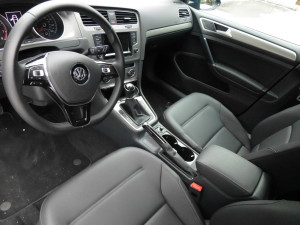
Interior of the Golf TSI welcomes occupants with simple but ergonomically pleasing seats and controls.
“The new 1.8 uses a small turbo, with a long stroke, for improved torque,” Trahan said. “It’s better than the old 2.0, with a lot more power and a lot more fuel-efficiency.”
The “old” 2.0 is the turbo that made its name powering the GTI, which is next up for a trial run. It is now powered by a new 2.0, also improved in every way.You have to try the GTI, to see if it can still fly above and beyond the more normal Golf models. And it does. Firmer stance, more responsive steering, and more agile handling, all the benefits of that new and stiffer platform, and those super-low-profile 225-40/18 tires on special alloy wheels.
The upgraded 2.0-liter turbocharged 4 makes you appreciate that the sportier interior, including racy steering wheel with its flat-bottom design and the much firmer Recaro bucket seats, are only tip-offs to the heightened performance waiting to turn you on. With 210 or 220 horsepower and 258 foot-pounds of torque, the GTI never disappoints. The original “hot hatch” is still hot, and even though there are competitors that might be hotter, few are as compliant, comfortable and totally satisfying to drive as the GTI. Loaded, if you choose to add the 6-speed direct-sequential transmission instead of the excellent 6-speed stick, you rise to about $32,000.
The GTI has a standard 210 horsepower, or the performance-package 220, although it will take premium fuel to make it sing properly, and yet it has highway fuel estimates of 34 mpg, better than many economy-only compacts. When I had a red GTI with a 6-speed stick for a week, we had no trouble clocking 32 mpg even while running the revs up.
Finally, and maybe even hesitantly, you climb into the TDI Golf, with the 2.0-liter turbo-diesel 4-cylinder engine. You have heard much about how this engine, whether in a Golf, Jetta, Passat, or even assorted Audi models, is a durable, high-mileage gem. And it was, as the last generation turbo-diesel just finishing its splendid run. Now the 2.0 TDI is an all-new 2.0 TDI. What other company would take a state-of-the-art 2.0 turbo-diesel, which was the envy of the rest of the industry, and replace it with an entirely new 2.0 turbo-diesel?
When it comes to performance, the new “clean diesel” TDI takes off as if to prove it is an esteemed relative of the GTI. That tremendous low-end acceleration has nothing to do with its modest 150 horsepower, but is directly attributable to its 236 foot-pounds of torque, which reaches that peak at a mere 1,750 RPMs. Highway EPA estimates are 47 mpg, and there are documented tests of traveling up to 550 miles on a tankful of fuel.
Diesels, which fire by compressing the fuel until explosion in each cylinder rather than igniting it by a direct spark, don’t rev particularly high, because they don’t need to. Once you get to 3,500 revs, you might as well shift because you’re well past the torque’s reach and shifting will puts you back near peak torque. So it won’t beat its siblings to 60, but from 0-40 and whenever you need a dose of mid-range power to pass, it is amazingly proficient.
The new diesels that burn clean-diesel fuel betray none of the loudness, clattering, smokiness and generally oily liabilities of old diesels. Before we cleaned up our diesel fuel in the U.S., our oil companies made inferior diesel fuel with something over 400 parts per million of sulfur, which was the true culprit for all the smoke and smell. Our clean diesel is restricted to 15 parts per million sulfur, eliminating the smell, clattering and sooty, greasy residue, although we’re still behind the Europeans, which have lowered allowable sulfur from 12 to 7 parts per million.
It takes much less refining to make diesel fuel than to make gasoline, so fuel companies can regulate how much of their petroleum they make into diesel fuel, and create an artificial shortage, thus charging whatever they want for it. That’s why diesel fuel, which used to cost 20 cents less than regular, now might cost in excess of a dollar more than premium at the pumps. That price has prevented some companies from bringing in their best diesel-powered cars. If diesel fuel was priced where it should be, more companies would bring in their best diesels, and we’d all be breathing better and getting phenomenal mileage.
The Golf models provide perfect evidence of fuel efficiency. I tend to go by a car’s highway EPA estimate, because that provides the best target to shoot for. The 1.8 TSI has a maximum EPA estimate of 36 highway mpg, the 2.0 GTI turbo shows 34 mpg, and the 2.0 TDI a highway estimate of 45 mpg. The U.S. restrictions on diesel emissions are unfairly strict, and help prevent companies from bothering to certify their cleanest diesel engine models from U.S. entry. But clean-running diesels might surprise consumers, as well as EPA officials.
In a recent issue, Motor Trend posted a comparison of the CO2 emissions from different engines, and found that the 2.0 turbo gas engine in the GTI emits 0.68 pounds of CO2 per mile, while the 1.8 TSI turbo emits 0.67 pounds per mile. The 2.0 TDI turbo-diesel — which most might guess was the foulest of the three — emits only 0.63 pounds of CO2 per mile.
Of course, if you want rock-bottom emissions, by the end of spring, 2015, we will have a plug-in, zero-emission choice , the e-Golf — an all-electric model that costs a modest $35,000. I’ve driven all the Golfs, including the e-Golf, and the electric model is a strong performer, with the equivalent of 115 horsepower and 199 foot-pounds of torque. The torque from the permanent-magnet electric motor, as in all electric car operation, comes on fully at 0 RPMs.
The e-Golf acceleration is similar to the TDI, but the emissions are 0.00 in levels of CO2. With plug-in electric cars, the biggest factor is how far you can go between recharging, and the e-Golf claims 83-90 miles from its high-tech 264-cell lithium-ion battery pack, made by Panasonic. VW also claims that its new charging device can recharge 80 percent of the e-Golf’s full charge in only 30 minutes.
The full fleet of Golf models won Motor Trend’s 2015 Car of the Year award, and the family joins the Ford Mustang and the Hyundai Genesis among the three finalists for 2015 North American Car of the Year. The Golf family will get bigger after January of 2015, when the new Golf SportWagen shows up. And later, the Golf R, which has nearly 400 horsepower from a super-tweaked 2.0 turbo gas engine, with all-wheel drive, will rise to a new level beyond the GTI.
The Golf total family won Motor Trend’s Car of the Year award for 2015, and I am one of 57 jurors pondering our final vote for the North American Car of the Year. It’s a tough decision, with the Mustang and Genesis, although the Golf clearly outnumbers its rivals.


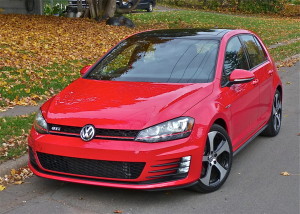
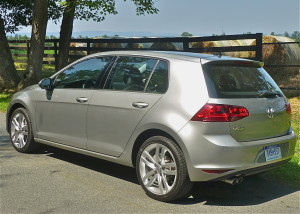
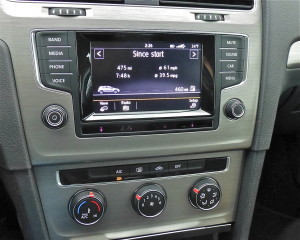
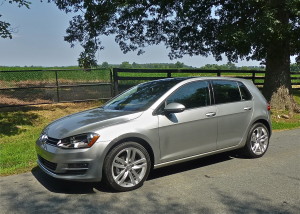
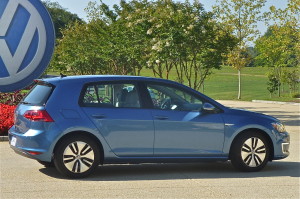
 John Gilbert is a lifetime Minnesotan and career journalist, specializing in cars and sports during and since spending 30 years at the Minneapolis Tribune, now the Star Tribune. More recently, he has continued translating the high-tech world of autos and sharing his passionate insights as a freelance writer/photographer/broadcaster. A member of the prestigious North American Car and Truck of the Year jury since 1993. John can be heard Monday-Friday from 9-11am on 610 KDAL(www.kdal610.com) on the "John Gilbert Show," and writes a column in the Duluth Reader.
John Gilbert is a lifetime Minnesotan and career journalist, specializing in cars and sports during and since spending 30 years at the Minneapolis Tribune, now the Star Tribune. More recently, he has continued translating the high-tech world of autos and sharing his passionate insights as a freelance writer/photographer/broadcaster. A member of the prestigious North American Car and Truck of the Year jury since 1993. John can be heard Monday-Friday from 9-11am on 610 KDAL(www.kdal610.com) on the "John Gilbert Show," and writes a column in the Duluth Reader.